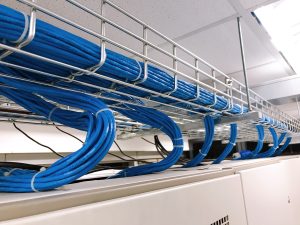According to America’s National Cybersecurity and Infrastructure Security Agency (CISA), a K-12 school falls victim to a cybersecurity attack every single day. Cyber threat monitoring is essential for the day to day operations and infrastructural management of K-12 organizations for a number of reasons, and can help keep your students, staff, and data protected from the dangers of a cyber and/or malware attack. Keep reading for a comprehensive guide on the ins, outs, and importance of cyber threat monitoring in today’s ever-changing technological landscape.
Table of Contents
What is Cyber Threat Monitoring?
Why is Cyber Threat Monitoring Important?
How Does Cyber Threat Monitoring Work?
How to Choose a the Best Cyber Threat Monitoring Strategy for Your Educational Organization
Looking for a Cyber Threat Monitoring Provider You Can Rely On?
What is Cyber Threat Monitoring?
Cyber threat monitoring is the continuous process of detecting, analyzing, and responding to cyber threats that could potentially harm an organization’s information systems. It involves the use of various tools and techniques which can identify suspicious activities and potential security breaches in real time. The goal of cyber threat monitoring is to ensure the security and integrity of an organization’s digital assets by providing early detection and timely responses to any potential or active cyber threats.
Key Components of Cyber Threat Monitoring:
- Network Assessment: IT Service Providers collect data on network traffic, system logs, user activities, and other infrastructural system properties in order to create a comprehensive outline of the organization’s IT environment.
- Threat Detection and Analysis: IT providers identify potential threats by analyzing the collected data for any potential network weaknesses, indicators of compromise (IoCs), and any unusual behavior that deviates from the norm. They then analyze these threats to understand their nature, origin, and potential impact on the organization.
- Cyber Threat Response Services: IT Service providers then take appropriate actions to mitigate the identified threats. This can include blocking malicious IP addresses, isolating affected systems, or deploying patches and updates to fix vulnerabilities.
- Reporting and Alerts: Cyber threat service providers often generate reports and alerts to inform organizations and stakeholders about the status of the organization’s security posture and any potential or detected threats. These reports help in making informed decisions regarding the organization’s current and future cybersecurity strategy.

Why is Cyber Threat Monitoring Important?
Cyber threat monitoring can help protect various essential aspects of your educational organization, including:
- Student Data: Cyber threat monitoring safeguards sensitive student information such as names, addresses, birthdates, and educational records. This service works to prevent the disastrous consequences that can result from attempts to violate the private records of your organization.
- Learning Environments: Cyber threat monitoring works to secure the digital environments for educational organizations’ multiple online learning platforms, communication tools, and overall learning resources. This ensures that students and educators can use these platforms without the risk of cyber attacks disrupting the educational process.
- Legal and Regulatory Compliance Methods: Cyber threat monitoring services help schools adhere to laws and regulations such as the Family Educational Rights and Privacy Act (FERPA) and the Children’s Internet Protection Act (CIPA). This helps schools avoid costly legal penalties and other negative consequences of legal non-compliance.
- Financial Information: Cyber threat monitoring services work to protect financial data related to school budgets, payroll, and operational transactions, which decreases the likelihood of financial fraud and ensures that school resources are secure and readily available for future use.
- Institutional Reputation: Cyber threat monitoring protects the reputation of the school or district by preventing high-profile security breaches, consequently building trust among parents, students, staff, and the community as a whole.
- Remote and Hybrid Learning: Cyber threat monitoring supports the function of remote and hybrid learning environments by ensuring that students and teachers can safely and securely access learning materials and participate in classes from any location.
By implementing robust cyber threat monitoring practices, K-12 educational organizations can protect their students, staff, and resources from cyber threats, thus promoting a safe and secure learning environment for their students.
Types of Cyber Threats
There are various types of cyber threats which, when directed at your school or organization, can have long-lasting consequences on both short and long term operations. Some of the most prevalent types of cyber threats are malware attacks, which refers to any type of software designed to harm, exploit, or otherwise compromise the functionality, security, or data of a computer system, network, or device. Malware can perform a variety of malicious tasks, such as stealing sensitive information, damaging data, disrupting services, or taking control of a system. These attacks can target your network in multiple ways, like email phishing attempts, malicious website invitations, ads, software installs, or other methods of malware attack transmission.
There are many different types of malware which can be installed into your network, including:
- Viruses: Malware that attaches itself to a legitimate program or file and spreads to other programs or files when executed.
- Worms: Self-replicating malware that spreads independently of any host file, typically over a network.
- Trojans: Malware disguised as legitimate software, which tricks users into installing them. Once installed, they can execute malicious network-based activities and damage system infrastructure.
- Ransomware: Malware which encrypts a victim’s data and demands payment in order to restore access.
- Spyware: Malware which secretly monitors and collects information about users’ activities without their knowledge.
- Adware: Malware which displays unwanted advertisements on a user’s device, often in the form of pop-ups.
Understanding, recognizing, and combating these types of malware is crucial for protecting your educational organization’s systems and data.
How Does Cyber Threat Monitoring Work?
IT Service Providers use a variety of tools and techniques in order to keep your educational organization safe and protected, including:
- Intrusion Detection Systems (IDS): Network security software that monitors network traffic and devices for suspicious or malicious activity and alerts service providers/users of any potential network threats.
- Security Information and Event Management (SIEM): Network security software that monitors network traffic and devices for suspicious or malicious activity, alerts service providers/users of any potential network threats, and allows users to take preventative actions against potential network threats.
- Endpoint Detection and Response (EDR): Network security software that monitors network traffic and devices for suspicious or malicious activity, alerts service providers/users of any potential network threats, and allows users to take both preventative and reactive actions against potential network threats in order to fully investigate and eliminate the targeted attack.
- Threat Intelligence Platforms (TIP): Network security software that monitors network traffic and devices for suspicious or malicious activity, alerts service providers/users of any potential network threats, and presents users with a comprehensive threat analysis, allowing threat analysts to focus on investigating and eliminating the targeted attack.
- Network Traffic Analysis (NTA): Network security software that monitors network traffic and devices in order to understand how a computer network normally behaves and performs. NTA involves examining the patterns, protocols, and volume of data flowing through a network to better understand how network devices and systems communicate with each other.
How to Choose the Best Cyber Threat Monitoring Provider for Your Educational Organization
Choosing the best cyber threat monitoring provider for a K-12 school involves several critical considerations to ensure comprehensive protection and minimal disruption to the operation of your educational environment. It’s essential to evaluate the provider’s experience and expertise in the education sector, as they should understand the unique challenges and regulatory requirements of schools in order to best provide robust and real-time threat detection and response capabilities which are tailored to the specific needs of K-12 institutions.
Additionally, the cyber threat monitoring provider should be easily and quickly accessible, in order to provide efficient aid in the case of a cyber attack. Providers should provide comprehensive cyber monitoring support options which require minimal to no support from school staff, in order to best allow educators to allocate all of their time and efforts to educating students and managing daily tasks (instead of worrying about cyber threats). It’s also important to assess the provider’s support and training services, which equip your school community with a detailed plan of response and action to take in the case of potential threats.
Finally, it is recommended to consider the cost-effectiveness of the solution and ensure that it fits within the school’s budget while still providing a high level of cyber protection. Keeping these factors in mind will help schools choose a reliable and effective cyber threat monitoring provider that can efficiently and effectively secure their digital environment while simultaneously meeting their unique organizational needs.
Looking for a Cyber Threat Monitoring Provider You Can Rely On?
Consider Clear Winds Technologies! With over 20+ years of IT experience, Clear Winds’ team of expert engineers and technicians is passionate about providing educational organizations just like yours with tailored IT support whenever and wherever you need it most. Don’t wait until a cyber attack happens to start your search for an IT provider you can trust- visit our website or call us at 205-986-4490 to learn more about how Clear Winds Technologies can help keep your school, students, and staff secure from the disastrous consequences of cyber threats.



